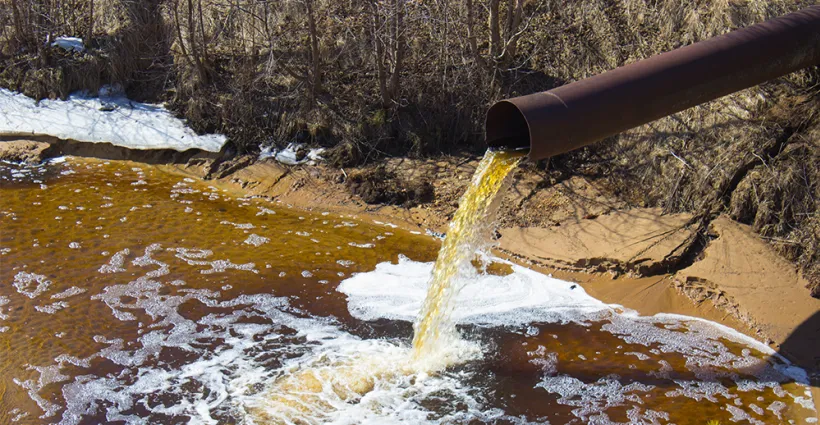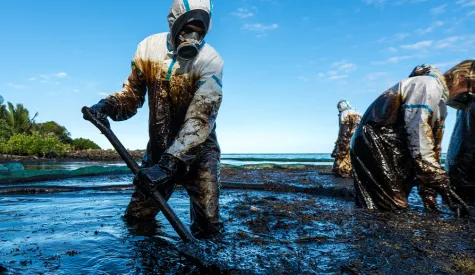Industrial Facilities: Stormwater Pollution

Stormwater pollution is a major concern for many industrial facilities. Fines can be levied against companies that violate stormwater pollution laws. These fines, as well as damage to the local water supply, can be prevented by creating and following a National Pollutant Discharge Elimination System (NPDES) permit and a Stormwater Pollution Prevention Plan (SWPP).
NPDES Permits and SWPPP
Both the NPDES and SWPPP are part of the Federal Water Pollution Control Administration Amendments, which were enacted in 1972 – two years after the Environmental Protection Agency (EPA) was formed. These amendments were created in response to the Cyuahoga River fire of 1969 and other similar events.
The NPDES permit program helps address water pollution by regulating the point sources that discharge pollutants into U.S. waters. Essentially, NPDES permits control what pollutants and how many your company can discharge.

In addition to the NPDES permit, companies are required to maintain an SWPPP. Unlike the NPDES, which can apply to multiple companies depending on the permit, the SWPP applies only to a single facility. SWPPPs are a critical part of a facility’s stormwater pollution management. The plan covers the following:
- Facility layout
- Inventory of materials that could be exposed to stormwater
- Likely sources of pollutants
- History of spills and leaks within the last three years
- Measures and controls that will be implemented to prevent and/or minimize stormwater pollution
Following the SWPPP is one of the most critical components of preventing stormwater pollution, and both the company and employees must participate for it to be successful.
What Causes Stormwater Pollution?
The EPA has identified six types of activities at industrial facilities as potentially major sources of stormwater pollution. Industrial facilities perform some or all of these activities which include:
- Loading and unloading operations
- Outdoor storage
- Outdoor process activities
- Dust or particulate generating processes
- Illicit connections and non-stormwater discharges
- Waste management

Any of the activities performed at a facility must be included in the SWPPP, along with the procedures to reduce or eliminate their pollutant discharges into the stormwater.
Consequences
If left untouched, stormwater pollution will affect the water in which we swim and fish. Some of the consequences of unchecked pollution include damage to aquatic plants, habitat loss due to trash, and reduced oxygen in the water. If a facility is discharging into U.S. waters, it should already have both an NPDES permit and SWPPP in place. An SWPP includes both baseline and advanced best management practices, or BMPs.
A baseline BMP is something that can be done quickly and easily, often at no or limited cost. An example would be always replacing and tightening the lid after using a chemical. Advanced BMPs require planning and typically a larger budget. For example, an advanced BMP might be building a berm to keep rainwater from flowing into a work area. Facilities have a mix of baseline and advanced BMPs. Both types are important in preventing stormwater pollution.
Simple Steps to Prevent Pollution
Even if employees don’t play a significant role in the SWPPP, they can still perform tasks to support the plan. Many baseline BMPs could apply to any facility and can be performed on a regular basis by any employee. Some examples are:
- Picking up trash and other debris
- Putting trash and recyclables in the correct collection place
- Keeping lids on outside dumpsters
- Checking storm drains and culverts after a rain event and removing any trash
- Covering any materials that could wash away like sand or gravel

Most of these tasks should be performed daily by all employees, particularly making sure to put trash in the right receptacle. Even these small efforts can make a huge difference in preventing trash from entering nearby water.
Employees can also assist with preventing leaks, spills, and the improper use and disposal of chemicals. From fuels and cleaning solvents to pesticides and fertilizers, every employee will likely handle a chemical that shouldn’t enter stormwater at some point.
To help employees decrease their risk of polluting stormwater, the correct containers should be supplied and employees should be encouraged to use the smallest size available for the task. In addition, employees should always put the cover back on any product they use once they’ve completed a transfer or task. Prevention is always better than trying to contain a spill.
Employers already have many responsibilities when it comes to preventing stormwater pollution or illegal discharges. Once of the most important is performing frequent inspections at least once a month. These inspections ensure issues are quickly found and corrected and any insufficient BMPs are addressed.
Without proper planning, stormwater pollution could easily become a financial catastrophe for an unprepared facility. By planning and ensuring compliance with your NPDES permit and SWPPP, you can prevent a small leak from becoming a big headache.

